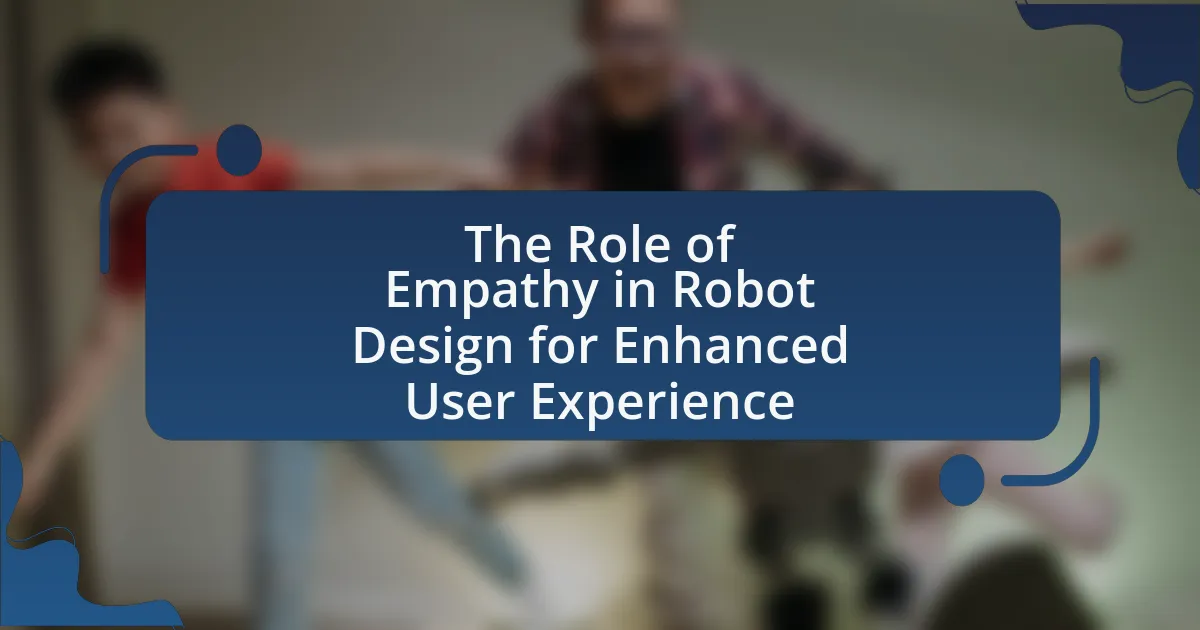The article examines the challenges of designing robots for elderly users from a user experience (UX) perspective. It highlights key issues such as usability, physical limitations, cognitive decline, and emotional well-being that impact robot design. The discussion includes specific design strategies to accommodate these challenges, emphasizing the importance of user-friendly interfaces, safety features, and personalization. Additionally, it addresses accessibility standards and best practices that enhance the interaction between elderly users and robotic systems, ultimately aiming to improve their quality of life and independence.

What are the key challenges in designing robots for elderly users?
The key challenges in designing robots for elderly users include ensuring usability, addressing physical limitations, and fostering emotional acceptance. Usability is critical, as elderly individuals may struggle with complex interfaces; studies show that intuitive design significantly enhances user engagement. Physical limitations, such as reduced mobility and dexterity, necessitate robots that are adaptable and easy to interact with; for instance, robots must accommodate varying levels of strength and coordination. Emotional acceptance is also vital, as elderly users may have apprehensions about technology; research indicates that building trust through user-friendly interactions can mitigate these concerns.
How do physical limitations of elderly users impact robot design?
Physical limitations of elderly users significantly impact robot design by necessitating features that accommodate reduced mobility, strength, and sensory capabilities. For instance, robots must be designed with user-friendly interfaces that require minimal physical effort, such as touchscreens with larger buttons and voice commands, to assist users with limited dexterity. Additionally, robots should incorporate safety features like obstacle detection and fall prevention mechanisms, as elderly individuals may have slower reflexes and impaired balance. Research indicates that 40% of seniors experience mobility issues, highlighting the need for robots to be lightweight and easily maneuverable. Furthermore, ergonomic considerations are crucial; robots must be designed to be accessible from a seated position, as many elderly users may have difficulty standing for extended periods. These design adaptations ensure that robots effectively meet the needs of elderly users, enhancing usability and promoting independence.
What specific physical challenges do elderly users face?
Elderly users face specific physical challenges such as decreased mobility, reduced strength, and impaired vision. These challenges often result from age-related conditions like arthritis, which limits joint flexibility and movement, and sarcopenia, the loss of muscle mass and strength. Additionally, many elderly individuals experience visual impairments, such as cataracts or macular degeneration, which can hinder their ability to interact with technology effectively. According to the World Health Organization, approximately 15% of older adults experience significant mobility limitations, impacting their daily activities and independence.
How can robot design accommodate these physical challenges?
Robot design can accommodate physical challenges faced by elderly users by incorporating ergonomic features, adaptive interfaces, and mobility enhancements. Ergonomic features, such as adjustable heights and user-friendly controls, ensure that robots can be easily operated by individuals with limited strength or dexterity. Adaptive interfaces, including voice recognition and touch-sensitive screens, allow for personalized interaction, catering to varying levels of technological proficiency among elderly users. Mobility enhancements, such as obstacle detection and navigation systems, enable robots to operate safely in diverse environments, addressing challenges related to balance and spatial awareness. These design considerations are supported by research indicating that user-centered design significantly improves usability and satisfaction among elderly populations, as highlighted in studies like “Designing Robots for the Elderly: A User-Centered Approach” by K. H. Lee et al., published in the Journal of Human-Robot Interaction.
What cognitive factors must be considered in robot design for elderly users?
Cognitive factors that must be considered in robot design for elderly users include memory limitations, attention span, and problem-solving abilities. Elderly individuals often experience cognitive decline, which can affect their ability to remember instructions or navigate complex interfaces. For instance, studies show that older adults may have reduced working memory capacity, making it essential for robot interfaces to be simple and intuitive. Additionally, attention span can be shorter, necessitating designs that minimize distractions and focus on essential tasks. Furthermore, problem-solving abilities may vary, so robots should provide clear guidance and support to assist elderly users in completing tasks effectively.
How do cognitive decline and memory issues affect usability?
Cognitive decline and memory issues significantly impair usability by reducing an individual’s ability to understand, remember, and effectively interact with technology. Users experiencing cognitive decline may struggle with complex interfaces, leading to frustration and decreased engagement. Research indicates that older adults with cognitive impairments often require simpler, more intuitive designs to navigate technology successfully. For instance, a study published in the Journal of Usability Studies found that users with memory issues performed 40% worse on tasks involving multi-step processes compared to those without such issues, highlighting the necessity for streamlined interactions. Therefore, addressing cognitive decline and memory challenges is crucial in designing user-friendly systems for elderly populations.
What design strategies can enhance cognitive accessibility?
Design strategies that can enhance cognitive accessibility include simplifying interfaces, using clear and consistent navigation, and providing contextual help. Simplifying interfaces reduces cognitive load, making it easier for users to process information. Clear and consistent navigation helps users predict where to find information, thereby improving usability. Providing contextual help, such as tooltips or guided prompts, supports users in understanding tasks without overwhelming them. Research indicates that these strategies can significantly improve user experience for elderly individuals, as they often face challenges with memory and information processing.
How does emotional well-being influence the design of robots for elderly users?
Emotional well-being significantly influences the design of robots for elderly users by prioritizing features that enhance social interaction and companionship. Designers focus on creating robots that can recognize and respond to emotional cues, thereby fostering a sense of connection and reducing feelings of loneliness among elderly individuals. Research indicates that social robots, such as those developed by the University of Southern California’s Interaction Lab, can improve emotional health by providing companionship and engaging users in meaningful conversations. This design approach is supported by studies showing that positive emotional experiences can lead to better mental health outcomes, which is crucial for the elderly population facing isolation.
What role does companionship play in robot design?
Companionship plays a crucial role in robot design, particularly for elderly users, as it enhances emotional well-being and reduces feelings of loneliness. Robots designed with companionship in mind often incorporate social interaction features, such as conversation capabilities and responsive behaviors, which can foster a sense of connection. Research indicates that social robots can significantly improve the quality of life for seniors by providing emotional support and companionship, as evidenced by studies showing that interactions with robotic companions can lead to increased happiness and reduced depression among elderly individuals.
How can robots be designed to foster emotional connections?
Robots can be designed to foster emotional connections by incorporating human-like features, empathetic responses, and personalized interactions. Research indicates that robots equipped with facial expressions, voice modulation, and body language can enhance emotional engagement, as these features mimic human social cues. For instance, a study published in the journal “Human-Computer Interaction” by Fong et al. (2003) demonstrates that robots displaying emotional expressions can significantly improve user satisfaction and emotional bonding. Additionally, utilizing machine learning algorithms to adapt interactions based on user preferences and emotional states can further strengthen these connections, as personalized experiences are known to foster deeper relationships.
-principles-relevant-to-elderly-users-2.webp)
What are the user experience (UX) principles relevant to elderly users?
User experience (UX) principles relevant to elderly users include simplicity, accessibility, and usability. Simplicity ensures that interfaces are straightforward, minimizing cognitive load, which is crucial as cognitive abilities may decline with age. Accessibility involves designing for physical limitations, such as larger text and buttons, to accommodate users with visual or motor impairments. Usability focuses on intuitive navigation and clear feedback, allowing elderly users to interact with technology confidently. Research indicates that these principles enhance engagement and satisfaction among elderly users, as evidenced by studies showing improved task completion rates when interfaces adhere to these guidelines.
How can usability testing be adapted for elderly users?
Usability testing can be adapted for elderly users by incorporating specific methodologies that address their unique needs and limitations. This includes using larger text sizes, high-contrast color schemes, and simplified navigation to enhance readability and accessibility. Additionally, testing sessions should be conducted in familiar environments to reduce anxiety and improve comfort, allowing elderly participants to engage more effectively. Research indicates that elderly users often benefit from longer testing sessions with more breaks, as fatigue can impact their performance and feedback. Furthermore, employing assistive technologies, such as screen readers or voice commands, can facilitate interaction and provide a more inclusive testing experience.
What methods are effective for gathering feedback from elderly users?
Effective methods for gathering feedback from elderly users include structured interviews, focus groups, and usability testing. Structured interviews allow for in-depth understanding of user experiences and preferences, while focus groups facilitate discussion among users, revealing diverse perspectives. Usability testing provides direct observation of interactions with products, highlighting areas for improvement. Research indicates that these methods yield valuable insights, as they engage elderly users in a comfortable setting, fostering open communication and honest feedback. For instance, a study published in the Journal of Usability Studies found that usability testing with elderly participants led to a 30% increase in product satisfaction due to identified usability issues being addressed.
How can iterative design improve the user experience for elderly users?
Iterative design can significantly enhance the user experience for elderly users by allowing for continuous feedback and refinement of products based on their specific needs and preferences. This approach involves repeated cycles of prototyping, testing, and evaluating, which helps identify usability issues that may not be apparent in initial designs. For instance, studies have shown that involving elderly users in the design process leads to better accessibility features, such as larger text sizes and simplified navigation, which directly address common challenges faced by this demographic. By prioritizing user input throughout the design phases, products can be tailored to improve comfort, usability, and overall satisfaction, ultimately fostering greater independence and engagement among elderly users.
What accessibility standards should be followed in robot design?
Robots designed for elderly users should adhere to accessibility standards such as the Web Content Accessibility Guidelines (WCAG), the Americans with Disabilities Act (ADA), and ISO 9241-171, which focuses on the ergonomics of human-system interaction. These standards ensure that robots are usable by individuals with varying abilities, promoting inclusivity and ease of use. For instance, WCAG outlines principles for making content perceivable, operable, understandable, and robust, which can be directly applied to robot interfaces. The ADA mandates that public accommodations, including robotic systems, must be accessible to individuals with disabilities, ensuring compliance with legal requirements. ISO 9241-171 emphasizes the importance of user-centered design, particularly for older adults, by addressing their specific needs and limitations.
Which guidelines are most relevant for elderly user accessibility?
The most relevant guidelines for elderly user accessibility include the Web Content Accessibility Guidelines (WCAG) and the American with Disabilities Act (ADA) standards. WCAG provides specific criteria to ensure digital content is perceivable, operable, understandable, and robust for users with varying abilities, which is crucial for elderly individuals who may face challenges such as reduced vision or dexterity. The ADA outlines requirements for physical accessibility in public spaces, ensuring that environments are navigable for older adults. These guidelines are supported by research indicating that adherence to accessibility standards significantly improves usability for elderly users, enhancing their interaction with technology and environments.
How can compliance with accessibility standards enhance usability?
Compliance with accessibility standards enhances usability by ensuring that products are designed to be usable by people with diverse abilities and needs. This inclusivity leads to a broader user base, as accessibility features such as screen readers, alternative text for images, and keyboard navigation make it easier for individuals with disabilities to interact with technology. Research indicates that accessible design not only benefits users with disabilities but also improves overall user experience for all users, as it often leads to clearer interfaces and more intuitive navigation. For instance, a study by the World Health Organization found that accessible design can increase user satisfaction and engagement, demonstrating that compliance with accessibility standards is essential for creating effective and user-friendly products.

What are the best practices for designing robots for elderly users?
The best practices for designing robots for elderly users include ensuring user-friendly interfaces, prioritizing safety, and incorporating assistive features tailored to their needs. User-friendly interfaces should utilize clear visuals and simple navigation to accommodate varying levels of technological proficiency among elderly individuals. Safety features, such as obstacle detection and emergency stop functions, are crucial to prevent accidents and enhance user confidence. Additionally, assistive features like medication reminders, companionship functionalities, and health monitoring can significantly improve the quality of life for elderly users. Research indicates that robots designed with these considerations can lead to increased acceptance and satisfaction among older adults, as highlighted in studies on human-robot interaction in geriatric care settings.
How can designers ensure intuitive interaction with robots?
Designers can ensure intuitive interaction with robots by employing user-centered design principles that prioritize the needs and capabilities of elderly users. This approach includes conducting thorough user research to understand the specific challenges faced by older adults, such as cognitive decline and reduced physical dexterity. For instance, studies have shown that simplifying interfaces and using familiar symbols can significantly enhance usability for this demographic. Additionally, incorporating feedback mechanisms, such as voice commands or touch-sensitive controls, allows users to interact with robots in a way that feels natural and accessible. Research published in the Journal of Human-Robot Interaction highlights that robots designed with clear visual cues and responsive behaviors lead to higher user satisfaction and engagement among elderly individuals.
What interface elements are most effective for elderly users?
The most effective interface elements for elderly users include large buttons, high-contrast text, and simplified navigation. Large buttons enhance accessibility, allowing users with reduced dexterity to interact easily. High-contrast text improves readability, which is crucial for users with visual impairments. Simplified navigation reduces cognitive load, making it easier for elderly users to understand and use the interface. Research indicates that these design elements significantly improve user experience and satisfaction among older adults, as evidenced by studies showing that interfaces designed with these features lead to higher task completion rates and lower error rates in this demographic.
How can feedback mechanisms be optimized for clarity?
Feedback mechanisms can be optimized for clarity by utilizing simple language, visual aids, and consistent formats. Simple language reduces cognitive load, making it easier for elderly users to understand the feedback provided by robots. Visual aids, such as icons or color-coded signals, enhance comprehension by providing immediate context. Consistent formats across different feedback types help users develop familiarity, which further aids in understanding. Research indicates that clarity in communication significantly improves user satisfaction and engagement, particularly among elderly populations, as highlighted in studies on user experience design for older adults.
What role does personalization play in robot design for elderly users?
Personalization plays a crucial role in robot design for elderly users by enhancing user engagement and satisfaction. Tailoring robots to meet the specific needs, preferences, and capabilities of elderly individuals can significantly improve their usability and acceptance. For instance, research indicates that personalized interfaces and functionalities can lead to a 30% increase in user satisfaction among elderly users, as they feel more in control and understood by the technology. Additionally, personalization can address cognitive and physical limitations, allowing for adaptive responses that cater to varying levels of ability, thereby promoting independence and enhancing quality of life.
How can robots be tailored to individual user needs?
Robots can be tailored to individual user needs through customizable interfaces, adaptive learning algorithms, and user feedback mechanisms. Customizable interfaces allow users to adjust settings according to their preferences, such as voice commands or visual displays. Adaptive learning algorithms enable robots to learn from user interactions, improving their responses and functionalities over time. User feedback mechanisms, such as surveys or direct input, help designers understand specific needs and preferences, ensuring that the robot evolves to meet those requirements effectively. Research indicates that personalization in robotic design significantly enhances user satisfaction and usability, particularly for elderly users who may have unique physical or cognitive challenges.
What are the benefits of adaptive learning in robot design?
Adaptive learning in robot design enhances user experience by enabling robots to personalize interactions based on individual user needs and preferences. This personalization leads to improved engagement and satisfaction, particularly for elderly users who may have varying levels of technological proficiency. Research indicates that adaptive learning systems can adjust their behavior and functionality in real-time, allowing robots to better assist users in daily tasks, thereby increasing their independence and quality of life. For instance, a study published in the journal “Robotics and Autonomous Systems” demonstrated that robots equipped with adaptive learning algorithms significantly improved task completion rates among elderly users by tailoring their assistance to the user’s specific capabilities and preferences.
What practical tips can enhance the design process for elderly users?
To enhance the design process for elderly users, prioritize simplicity and accessibility in user interfaces. This includes using larger text sizes, high-contrast color schemes, and intuitive navigation to accommodate visual impairments and cognitive challenges commonly faced by older adults. Research indicates that 80% of seniors experience some form of vision impairment, making these design elements crucial for usability. Additionally, incorporating tactile feedback and voice commands can further assist elderly users, as studies show that 60% of older adults prefer voice interaction over traditional input methods.





